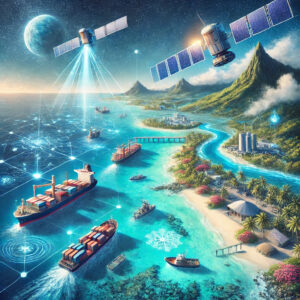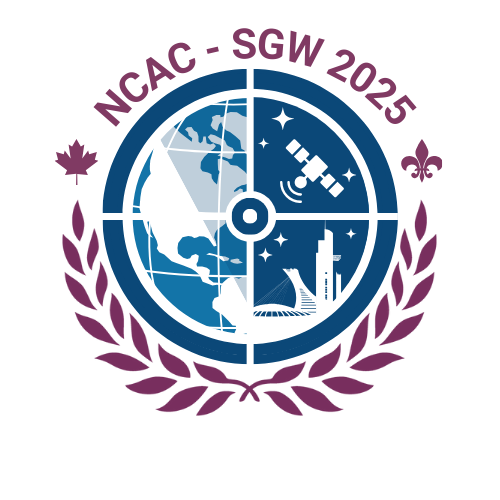Navigating the Blue: Leveraging Satellite Data for Maritime Security and the Blue Economy in Mauritius
By: Pallavi Rengasamy

THE CONCEPT OF PEACEFUL PURPOSES
On 3 June 2021, Mauritius launched its first satellite, the Mauritius Imagery and Radiocommunication Satellite 1 (MIR-SAT1)1 from the NASA Kennedy Space Centre in Florida via the SpaceX-CRS22 Cargo mission to the International Space Station. Deployed into orbit on 22 June 2021, this milestone was achieved through the KiboCUBE Programme, under the aegis of cooperation between the United Nations Office for Outer Space Affairs (UNOOSA) and the Japan Aerospace Exploration Agency (JAXA)2. A key objective of MIR-SAT13 was to capture data of the extensive Exclusive Economic Zone (EEZ) ofMauritius, spanning approximately 2.3 million square kilometres4. For Small Island Developing States (SIDS), space-based data can play a critical role in Maritime Domain Awareness (MDA)5, enhancing compliance with maritime security standards, enforcing Marine Protected Areas, and supporting sustainable management of marine resources.
Tools such as the Vessel Monitoring Systems (VMS) or the Long-Range Identification and Tracking of Ships (LRIT) mechanism, relating satellite information6, help the Ministry of Blue Economy, Marine Resources, Fisheries and Shipping in fisheries resource oversight and to assist the fight against Illegal, Unreported and Unregulated (IUU) fishing7. The Fisheries Monitoring Centre8 in Albion utilizes these systems to track activity within Mauritius’ EEZ. One of the enablers to achieve the goal of the Department for Continental Shelf, Maritime Zones Administration and Exploration to undertake strategic measures in the administration of maritimes zones in order to maintain peace and security within its territorial waters involves the institutional strengthening of remote sensing9 resources.
Under section 190 of the Fisheries Act, satellite-based information derived from satellites capable of providing accurate tracking relating to fishing vessels is considered to be admissible evidence with a presumption that it is deemed correct regardless of the intention to transmit such information. While it may be cautioned that a multitude of criteria may influence the evidentiary probative value of satellite-based evidence10, the provision facilitates regulatory enforcement and underscores the role of space-derived data in Mauritian fisheries management by shifting the burden of proof to the party challenging the evidence. Given the multi sectoral spread of the downstream applications of space-based and space-enabled data11, it may also signal potential avenues for the development of a harmonised national space framework.
Regionally, Mauritius participates in initiatives such as the European Union-funded Programme to Promote Regional Maritime Security (MASE), which involves more than 15 countries, and regional organizations. MASE aims to address transborder illicit actions through a cooperation perspective12 in the Western Indian Ocean. Space-derived data is part of the architecture applied by the information-gathering unit in their tracking of activities such as piracy, smuggling of narcotics and weapons, and trafficking in persons13. The call for space agencies and organisations to join the alliance for the ocean in support of the 2025 UN Conference on Sustainable Development Goal 14 to assist countries such as SIDS in tackling challenges like preserving marine biodiversity and combating IUU fishing through ocean-related data-sharing14 underlines the impact of downstream applications of space in these areas and the need for cooperation to strengthen evidence-based decision-making.
Mauritius’ inclusion of satellite data in domestic legislation highlights a small but growing legal area where space may be implemented at the national level to reinforce the portfolio of space-based tools for sustainable ocean management. Advancing local earth observation resources and implementing an overarching space framework will enhance MDA capabilities, assist in fulfilling international obligations, and support regional aspirations like the 2050 Africa’s Integrated Maritime (AIM) Strategy, bolstering Mauritius’ leverage of space for sustainable development and regional security – in maritime security and the blue economy and beyond.
1 Mauritius Research and Innovation Council (MRIC), ‘MIR-SAT1’ (MRIC, 2024) <https://spacemauritius.com/mir-sat1/>
2 United Nations Office for Outer Space Affairs (UNOOSA), ‘KiboCUBE: The Cooperation Programme between UNOOSA and JAXA on CubeSat Deployment from the International Space Station (ISS)’ (United Nations Office for Outer Space Affairs, 2020) <https://www.unoosa.org/documents/pdf/psa/hsti/KiboCUBE/20-05460_KiBocube_flyer_ebook.pdf>
3International Telecommunication Union (ITU), ‘Mauritius deploys first satellite into low-Earth orbit’ (ITU,
2021) <https://www.itu.int/hub/2021/06/mauritius-deploys-first-satellite-into-low-earth-orbit/>
4 Nairobi Convention Secretariat, ‘Mauritius Country Profile’ (Nairobi Convention Secretariat, n.d.) <https://www.nairobiconvention.org/mauritius-country-profile/ >
5 Martin Tsamenyi and Jaap Molenaar, ‘Satellite-Based Vessel Monitoring Systems for Fisheries Management: International Legal Aspects’ (2000) 15 The International Journal of Marine and Coastal Law 65-109 <https://doi.org/10.1163/157180800X00037>
6 Fisheries Act 2023 (Act No. 15 of 2023), s 2.
7 Ministry of Blue Economy, Marine Resources, Fisheries and Shipping, ‘Annual Report on Performance for the Financial Year 2023-2024’ (2024) <https://blueconomy.govmu.org/Documents/Publications/Annual%20Report%202023-24%20Final.pdf>
8 Ibid.
9 Department for Continental Shelf, Maritime Zones Administration & Exploration, ‘Strategic Actions’ (Prime Minister’s Office, n.d)<https://csmzae.govmu.org/Pages/Strategic%20Actions/Strategic-Actions.aspx>
10 Jonathan W. Hak, Image-Based Evidence in International Criminal Prosecutions (Oxford University Press 2024). See also: Jonathan W. Hak and Sabrina K. Rewald, ‘The Satellite Era: How Earth Observation Data is Being Mobilized as Potential Digital Evidence’ (EJIL:Talk!, 1 July 2024) <https://www.ejiltalk.org/the-satellite-era-how-earth-observation-data-is-being-mobilized-as-potential-digital-ev idence/>
11 Kenza Bousedra, ‘Downstream Space Activities in the New Space Era: Paradigm Shift and Evaluation Challenges’ (May 2023) 64 Space Policy 101553 <https://doi.org/10.1016/j.spacepol.2023.101553>
12 Christian Bueger, ‘Policy brief: Effective maritime domain awareness in the Indian Ocean’ (Institute for Security Studies, June 2017) <https://www.ifc.org.sg/ifc2web/Publications/Professional%20Reading/MDA%20WIO/MDA%20WIO.pdf>
13 Raj Mohabeer and Kate Sullivan de Estrada ‘Strengthening Maritime Security in the Western Indian Ocean: Introducing a state-of-the-art maritime security architecture in service of the Blue Economy’ (Indian Ocean Commission, 2019) <https://www.commissionoceanindien.org/wp content/uploads/2020/03/2020_PolicyBrief_web_en.pdf>. See also: Ministerial Declaration: 3rd Ministerial Conference on Maritime Security and Safety in the Western Indian Ocean <https://www.commissionoceanindien.org/wp-content/uploads/2023/11/231116_Eng_ADOPTED-Declaration-of-Ministerial-Conference-on-MARSEC.pdf>
14 UN, ‘Report of the Committee on the Peaceful Uses of Outer Space 67th session’ (19-28 June 2024) UN Doc A/79/20, para 288.


